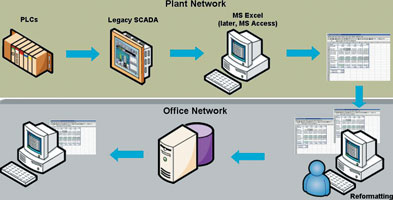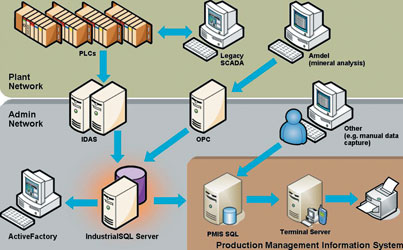
From the company’s inception, the source of all production information at Namakwa Sands Northern Operations was in the form of spreadsheets whose number kept growing while falling short of providing management the key decision-support information they needed when they needed it.
Pierre Cornelissen, IT Engineer, Systems Architecture and Integration, Namakwa Sands, says: "In the beginning, there was nothing but spreadsheets, spreadsheets and more spreadsheets. While spreadsheets have their uses, they were simply sources of data rather than information. They did not store real historical information, they were difficult to support and consumed time and effort at month-end. To compound the problem, spreadsheets did not only take up huge amounts of disk space but also generated a lot of duplicated effort and were difficult to integrate with other sources of information."
The initial topology at Namakwa Sands (Figure 1) was fairly typical of that found in growing companies whose growth outstrips the agility and adaptability of their information infrastructure.

Process information from PLCs captured by the scada system was sent to MS Excel (later MS Access) via DDE and the resulting spreadsheet was then sent to the office network where it was reformatted before being stored. Subsequently, more spreadsheets were derived by users from those already stored.
"But all this still did not give us historical information for yesterday or last week," continues Cornelissen. "The scada system could not store more than three days' worth of data and this was not enough to be useful. Plant engineers needed realtime information in their offices so that they could react quickly if necessary and an urgent need arose for a system that would monitor downtime. In amongst all this, the ability to monitor plant performance or to optimise processes all but disappeared."
To address these shortcomings, Namakwa Sands drew up a list of objectives that included:
* The elimination of spreadsheet systems.
* The right information on tap.
* Realtime plant performance information in the office.
* Production related information history.
* Downtime history.
* Plant performance and plant stability information.
Solution selection
Selecting a solution included looking at various alternatives, the first of which was to use the existing scada system as a data source and to use MS SQL 6.5 for data storage but this proved too slow and swamped the scada system. The second alternative was to develop an in-house application using an I/O driver connecting directly to the PLCs and again using MS SQL 6.5 for data storage but this would prove to be too costly on disk space. The third alternative was to use third-party realtime historians but, at the time, these were largely unproven.
"But then I heard about Wonderware's IndustrialSQL Server," says Cornelissen, "and, after a live demonstration with our own plant data, we decided that this was the way to go based on the proven technology of the product, its professional support and the ability to add integrated applications. We bought a licence for Brand-se-Baai and another for the Mineral Separation Plant (70 ktags each) and secured the services of system integrator Electrical/Instrumentation Engineering and Contracting (ENI)."
Initially, IndustrialSQL Server was used for trends only and the ActiveFactory workbook was used to link to Excel but this was once again going back to the bad habits of the past until a proposal was made to integrate all the company's different information sources under one roof from which all the required information could be collated and extracted. Management bought the concept provided that IndustrialSQL would provide information for:
* Downtime analysis.
* Plant stability and optimisation.
* Production status reporting.
* Quality assurance.
* Better reporting across the board.
* … and anything and everything else that could be dreamt up.
Implementation
"It took about 2½ years to develop PMIS, but it was well worth it," says Cornelissen. "Without Wonderware Southern Africa we could not have done it. One of our main challenges was to develop a data interface between IndustrialSQL Server and PMIS SQL. To do this, we used ActiveFactory's query tool extensively and today the interface works very well."

Several screens were developed to display, manage and provide drill-down facilities for KPIs (key performance indicators), plant performance, manual data capturing, downtime and the reasons for production stoppages. "We have a lot of information on downtime," says Cornelissen. "We can go back years if necessary and do comparisons as well as determine trends which place us in better control of our production processes."
Benefits
The seamless integration of data and its conversion into realtime and historical information has provided Namakwa Sands with numerous benefits that include:
* No more spreadsheet month-ends - this has resulted in a huge reduction in human effort.
* Realtime information - automation has resulted in eliminating hourly spreadsheet data capturing and the necessity for paper trails.
* Information on tap - the required information is there on demand and there is no more sifting through spreadsheets in the hope of finding what one needs.
* Reliable data - the reduction in human input has consequently reduced the amount of erroneous data.
* History and reporting - historical information can now go back years and reports, which previously took trained metallurgists two to three weeks to compile (rather than focusing on plant optimisation and the production of quality products), can now be done on demand by SQL and Crystal reports from the Data Server.
* Plant performance and optimisation - engineers now have real information on which to base cause-and-effect scenarios and process improvements.
For more information contact Justin Tweedie, Wonderware Southern Africa, 0861 WONDER, [email protected], www.wonderware.co.za

© Technews Publishing (Pty) Ltd | All Rights Reserved